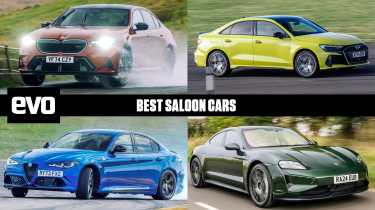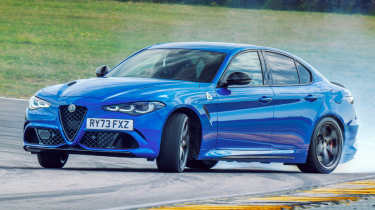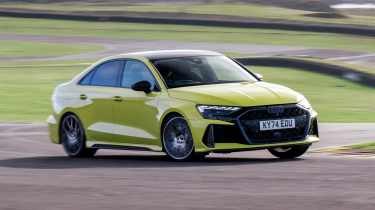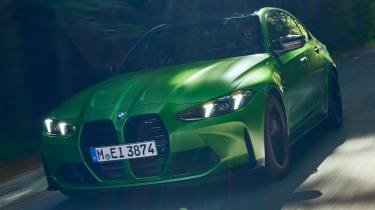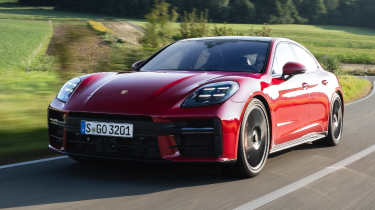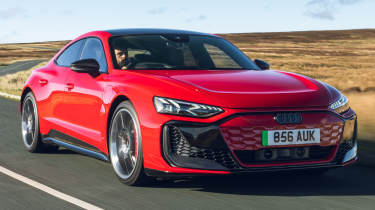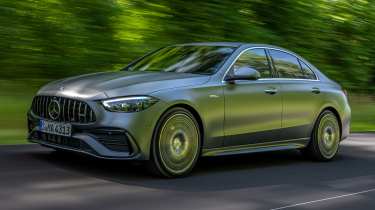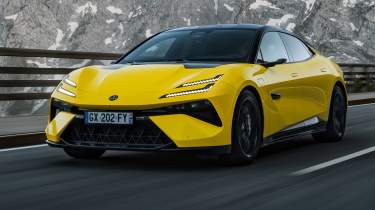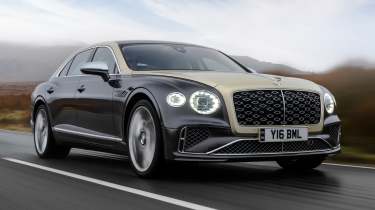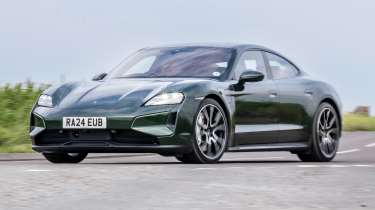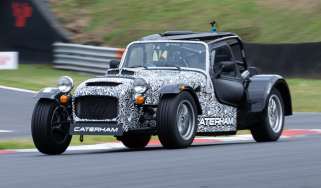Best saloon cars 2025 – fun performance cars with more doors
Great sports saloons as performant and engaging as sports cars and supercars but with the practicality to suit almost all day-to-day jobs. These are our current favourites.
The best sports and super saloons are still cars for all occasions, able to lunge across long distances with the best GTs and deliver near-sports and supercar thrills on the very best roads. In between, they are faithful family expresses, with decent boot space, four doors and Isofix. They’re attractive, even a little aggressive to look at, enough to catch glances of admiration from those who know. But they should also be unassuming and unpretentious to most others, almost blending in with the traffic around them, while doing all the same jobs without compromise.
In a very real sense, if you want one car to do it all, you need to look at some form of saloon. For if your acquiescence to practicality goes too far, you find yourself in a crossover or an SUV, the high-performance versions of which are simply too compromised to satisfy at a level those with evo sensibilities crave. Likewise, most coupes, sports and supercars, simply aren’t appropriate for a lot of the day-to-day jobs a super saloon will handle without a sweat.
This is an arena that has in the past been largely defined and dominated by the trifecta of German giants, Audi, BMW and Mercedes. They built their core lineups and reputations with a beloved bloodline of three-box machines but contenders and pretenders have always stepped up.
Despite the challenges facing traditional high-performance cars, the sports saloon and super saloon still have an immediate future thanks to electrification. This means that this list will likely look very different in 12 months' time as hybrid and electric powertrains lift the saloon to new heights of performance. Next year, there’s every chance we’ll be adding the new hybridised Audi RS5 to this list, while the new BMW M5, the new Porsche Taycan Turbo and Audi e-tron GT, already feature.
Best sports saloons 2025
- Alfa Romeo Giulia Quadrifoglio
- Audi RS3
- BMW M3 Competition
- Audi S5
- Porsche Panamera GTS
- BMW M5
- Audi e-tron GT
- Mercedes-AMG C43
- Lotus Emeya
- Bentley Flying Spur
- Porsche Taycan Turbo
Alfa Romeo Giulia Quadrifoglio
Prices from £86,885
Pros – Awesomely fast, amazingly approachable, full of charisma
Cons – Interior not a match for its rivals, reputation for flaky reliability
The Alfa Romeo Giulia Quadrifoglio has long been a firm evo favourite, with continuous developments since its 2016 launch keeping it dynamically sharp in the face of constant opposition. The latest tinkered-with Giulia QV brings extra power, a recalibrated chassis and a new mechanical limited-slip differential, elevating its talents still further. The Giulia Quadrifoglio is as a result is more approachable, tractable and alacritous than ever, still with the adjustability and sinewy twin turbo V6 muscle we’ve always adored it for.
At the heart of the Quadrifoglio lies a superb 90-degree twin-turbo 2.9-litre V6 that now kicks out 513bhp. It’s mated to an eight-speed auto that’s controlled by a pair of flamboyantly large aluminium paddles, driving the rear wheels via a carbonfibre prop shaft. The body is equally exotic, featuring a lightweight mix of carbon and aluminium panels wrapped around telephone-dial wheels, sophisticated double wishbone suspension and multi-way adaptive dampers. Oh, and did we mention its development was led by the same man who brought us the Ferrari 458 Speciale?
On the move the Alfa’s Ferrari DNA isn’t hard to spot. The big giveaways are the wrist-flick quick steering and surprisingly supple ride. Yet it’s the car’s poise, balance and grip when really pushing on that leaves the deepest impression – this is a tremendously fast and accomplished machine that’s more engaging than almost anything else with four doors. Sure, the optional carbon-ceramic brakes lack manners at low speed and the engine doesn't sound particularly musical (although it endows the Quadrifoglio with a brutal turn of speed), but these niggles don’t detract from what is a sublime saloon.
Alternatives to the Giulia Quadrifoglio
The small super saloon crop feels a bit thin at the moment, with the latest Mercedes-AMG C63 a non-option. Happily the BMW M3 is still around and on thoroughly fine form, even though it’s more like an M5 of 20 years ago than an M3. Audi’s out of the game for the moment until the new RS5 arrives, though you could go smaller (and more affordable) and get the warbling five-cylinder RS3 saloon (while you still can).
‘The traction the new diff enables is very impressive, in dry conditions at least. Even in Race mode, which as before disables the traction and stability control systems, you can get on the power remarkably early without wheelspin or the rear becoming unstable. And when you do deliberately wish to slide the car, it’s very progressive and intuitive. In cold, damp or greasy conditions it broadens the spectrum in which to control the car beyond the limit, with a clearer dialogue between car and driver. In short, the Giulia is now an easier car to control when traction is at a premium’ – James Taylor evo deputy editor, who ran the latest Giulia Quadrifoglio as a long term test car
Audi RS3
Prices from £63,120
Pros – Fabulous engine; exciting, playful chassis
Cons – Lacks the feedback and precision of the very best
The Audi RS3 clings on in 2025 in a familiar form: sharp of snout and making an entrance on a potent wave of five-cylinder warbling. Its days are surely numbered but they aren’t up yet, and arguably, a model that started life with a stumble is now on its finest form.
With adjustments and tuning to an already competent package, the RS3 in its updated form distances itself further from Audi Sport archetypes. It's keener to turn in, it’s more power-adjustable thanks to its torque-splitter rear differential, and its chassis breathes with a road or circuit better than it ever has. It’s a car in which you eventually realise, the instinct to scrub off speed to mitigate nose-heavy understeer can be unlearned. Even the non-ceramic brakes are up to the task of heaving the 1565kg RS3 to a stop with repeatable proficiency.
Of course, the engine remains the RS3’s star turn, it’s defining feature. Still bristling with muscle at 394bhp and 369lb-ft and still sounding like nothing else, the barrel-chested urgency with which it forces the RS3 up a straight stretch is irreplicable by rivals with fewer cylinders and less cubic capacity. It’s a joyous dinosaur.
Alternatives to the Audi RS3 Saloon
The RS3 Saloon is a curious device in the marketplace. It’s not a full-on BMW M2 rival, it’s an altogether different beast to that. BMW also doesn’t make a hotter version of the 2-series Gran Coupe beyond the M235 xDrive that meets the S3 saloon head on. Mercedes-AMG’s CLA 45 S runs it close. Otherwise, used Alfa Romeo Giulia Quadrifoglios and BMW M3s are worth a look, too.
‘Ultimately, the RS3 isn’t as tactile or immediate as a Civic Type R, or as cohesive and confidence inspiring as a GR Yaris. But exploring its peculiar dynamic makeup is a rewarding process, and the awesome presence and sound of the five-pot motor can’t be denied.’ – Stuart Gallagher, evo editor-in-chief who tested the Audi RS3 on road and track.
BMW M3 Competition
Prices from £89,635
Pros – As quick and capable as you could possibly want
Cons – Bigger and heavier than you’d possibly like
If you were to tell a die-hard BMW M fan 20 years ago that the BMW M3 was now a turbocharged, all-wheel-drive saloon with a weight figure close to that of the E39 M5, they might not have believed you. But as BMW M has proven time and time again, its ability to create brilliant performance cars through new generations of powertrain and chassis technology means the latest M3 is one of its finest.
While the CS version was one of the best saloons on the planet, it was a short-lived special, with the facelifted M3 Competition now taking the reins. We’ve yet to try the updated car on UK roads, but we can hope that it skims a bit of the CS’s dialled-up focus, power and capability off the top. The standard M3 Competition that came before was already an eCoty contender in 2021. Now for 2025, the updated car wades into battle with a boost to 523bhp from its twin-turbocharged straight six. The headline figures aren’t changed especially for the new M3 Competition, though the extra power does shave 0.6sec off its 0-124mph time, now down to 11.8sec for the saloon.
Though the rear-driven car is now no longer available, it’s no great loss. The xDrive was always the version that made this generation of M3. We can’t see a small boost in power, an updated steering wheel, new infotainment software and revised front lights ruining what is one of the most potent and desirable saloons of the last few years.
Alternatives to the BMW M3 Competition
The reality of buying a super saloon other than the BMW M3 Competition is that it’s a slight exercise in contrarianism. There are things the Alfa Romeo Giulia Quadrifoglio does better even than the latest M3 but now especially, its advancing years make it an esoteric choice. An excellent one, but esoteric all the same.
‘Perhaps the biggest compliment that can be paid to the new M3 is that while it may have proportions more suited to an M5 from a couple of generations ago, it manages to drive, steer and thrill in as close a fashion to an M2 Competition as is possible to get from a car that’s both bigger and heavier.’ – Stuart Gallagher, evo editor-in-chief, who tested the G80 M3 on the road in the UK.
Audi S5
Prices from £70,550
Pros – Quick, refined, balanced, well-equipped
Cons – Expensive, not the most thrilling
Audi’s recent flip-flopping over its naming convention where ICE models were to have odd number designations with EVs taking the even-numbers might have been ditched but the new Audi A5 and S5 were caught in the transition. These traditional coupe models have transitioned to the saloon and estate class previously occupied by the A4. It’s not just a badge with a bigger digit though, with the S5 bringing mild-hybrid technology, deftly-tuned adaptive dampers and a quattro sport limited-slip differential to the party.
We start with the engine, which is a derivative of the old 3-litre turbocharged V6, only it now features mild hybridity with a power generator and a variable geometry turbocharger for a healthy 362bhp and 269lb-ft. The result is improved response low down and better efficiency and emissions everywhere else, with 62mph arriving in 4.5sec on the way to a 155mph top speed. It may not be as powerful as the 400bhp-plus Mercedes C43 but the Audi S5 matches it in terms of acceleration.
It’s a surprisingly tuneful mill that’s enjoyable to play with up and down the rev range with the seven speed dual-clutch transmission. It’s also surprisingly composed at speed down a road, the adaptive dampers admirably controlling its not inconsiderable mass. Quite how this performance translates to the stressed surfaces of the UK’s road network remains to be seen. No, it doesn’t steer with the utmost tactility, but it has sharp responses and together with the diff, gets the S5 turned in with a keenness alien to some hot Audis.
The S5 is a fine car in and of itself, surprisingly so. What’s exciting, is the bandwidth left over for the upcoming RS5. For now, Audi’s small warmed-over saloon is the freshest and one of the best of its type.
Alternatives to the Audi S5
There are plenty of warm saloons to choose from that stand comparison to the S5. BMW’s M340i is the default choice if a dynamic feel is a priority. If you want a bit more of a plush, luxurious aesthetic inside (if not feel) then the Mercedes-AMG C43 is worth a look.
‘Turn-in on power is keen, while the amount the S5 is happy to send power to the outside rear wheel and spit itself sideways seems to directly correlate with how much steering angle is on. You won’t hold it for long in a balletic graceful drift, though. This simply isn’t in the S5’s nature. It’s happiest cultivating positive neutrality with the occasional flourish of rear-driven personality, without the natural, always rear-lead feel of a longitudinally-engined xDrive BMW.’ – Ethan Jupp, evo web editor, who tested the S5 on the launch and on the road in the UK.
Porsche Panamera GTS
Prices from: £131,700
Pros – A fast, satisfying and usable supersaloon
Cons – Needs more power and aggression to take on the BMW M5
Is the Porsche Panamera GTS a high-performance four-door coupe, a super saloon, or a luxurious limousine with an outrageous turn of speed? Regardless of how you view it, there’s no denying that it’s a deeply impressive piece of kit. Despite its size and weight it still goes and handles with the alacrity you’d expect from a car bearing the Porsche badge.
The big Porker was updated in 2024 and is resolute in GTS form, in sticking to pure combustion power, courtesy of a twin-turbo V8. While power is up from before, 493bhp isn’t exactly going to make the new 717bhp BMW M5 blush. That said, it does undercut the M5’s weight by over 300kg.
It’s not got the all-out intensity of some of the very best super saloons but there is a duality to its personality and truly unshakable capability. The chassis doesn’t use the new Active Ride suspension the Turbo S E-Hybrid gets but it’s 10mm lower than standard, riding on adaptive dampers and two-chamber air springs. It also gets stiffer anti-roll bars and a torque vectoring rear diff, adding agility.
The GTS could have been edgier to try and tempt BMW M5 CS owners away from their unicorn super saloons but there are subtleties to the GTS’s dynamic manners that are there to enjoy. Whatever way you look at it, it’s a compellingly capable machine.
Alternatives to the Porsche Panamera GTS
The Panamera as a model is positioned above conventional executive saloons such as the BMW 5-series and Mercedes-Benz E-Class, so it’s difficult to attribute direct rivals. For GTS money, however, it’s difficult to ignore that a well-optioned BMW M5 is very much within budget.
So too were the Audi RS7 Sportback Performance and Mercedes-AMG GT four-door, though both are now off-sale. If for some reason you’re not interested in internal combustion, Porsche’s own Taycan and the Audi e-tron GT are compelling options.
‘It stays composed and keyed in under high braking and cornering forces (particularly in the Sport damper setting – Sport Plus is too tense for the road), and breakaway at both axles is progressive and easy to read. It always feels like a big, substantial car, but the clean and accurate steering response means you can pick precise lines and build confidence for corner after corner. You need to work the paddles of the eight-speed PDK ‘box to punch away from them, but it’s easy to settle into a fast, satisfying flow in the GTS.’ – Yousuf Ashraf, evo senior staff writer, who tested the Panamera GTS on the launch.
BMW M5
Prices from £111,605
Pros – Still does everything you’d expect of an M5
Cons – Plus some stuff you don’t
The new BMW M5 has very big boots to fill, with the memory of the sublime BMW M5 CS still vivid in all our minds. The odds were against it, as its controversial kerb weight of over 2400kg had many doubting BMW M could possibly tie it down as an enjoyable and effective super saloon.
We needn’t have worried too much, as BMW has managed it. The new M5 is a masterclass in disguising mass, deploying its 717bhp (coming courtesy of the old 4.4-litre twin-turbo V8 with new hybrid tech) to devastating effect. It stops, goes, turns and controls itself with the decorum of a car hundreds of kilos lighter.
As infinitely adjustable as you may expect, the goldilocks zone is far from buried within the M5’s sprawling configurability. The do-everything ‘Comfort’ setting is excellent in its own right. Sport damping and steering aren’t really necessary for hustling on the road. The sport setting for the brakes does improve feel and obviously, Sport and Sport Plus settings for the powertrain allows you to call up the full 717bhp at will. The dynamic balance of the car is topped off by switching the 4wd to MDM mode, which adds a rear bias without switching the front axle off completely.
It still doesn’t flow with anything like the interactivity and life of the eCoty-winning M5 CS. Rather, it’s an M5 designed to expand the bandwidth of the badge, combining the ability to run on electric power for up to 43 miles, with an easily reached 190mph top speed (when the M Driver pack is added). It’s comfortable, cosseting, and almost infinitely capable.
Alternatives to the BMW M5
Unless you’re going for the slower, more expensive Panamera GTS, the M5 is a car without a direct rival at the moment, unless you’re looking at the Touring. The E53 isn’t up to it and the RS7 is off sale. The car that lingers in your consciousness when driving the new M5 is, of course, the old M5, plus its non-hybrid, V8 powered rival, the old E63. Sigh.
‘It feels like M engineers have given the car all the agility it should ever need but for everyday road driving has created a zone of calm around the steering’s centre, a place where you can work in a relaxed way. It feels wieldy with well-judged efforts, lovely linearity and a decent sense of what the front is doing, which is mostly going exactly where it’s pointed.’ – John Barker, evo editor-at-large, who tested the M5 on the road.
Audi e-tron GT
Prices from: £89,505
Pros – A comfortable, satisfying and impossibly fast electric GT
Cons – Inconsistent brake feel, Taycan has better steering and damping
The Audi e-tron GT has always been the unlikely sibling of the Porsche Taycan and indeed, an unlikely feather in the Audi Sport cap. For while electric cars and brutally fast cars are very much in Audi’s wheelhouse, there have been fewer dynamic, interactive, and adjustable saloons wearing the four rings. The e-tron GT is an exception, in spite of its weight, in spite of its size, in spite of being an EV – and in spite of its badge.
Updated in 2024, the e-tron GT range is now split into three, with the S e-tron GT that opens the range sporting power to match the old flagship, at 671bhp. The RS e-tron GT has a full-bodied 844bhp and if that’s not enough, the 912bhp RS e-Tron GT Performance should suffice. It’s not just a series of power bumps, either. It now has an active chassis system that uses air springs and hydraulically-connected active dampers, removing the need for anti-roll bars. There’s also a quicker steering rack and rear steering, all working together to make the e-tron GT more dynamic and agile, as well as faster. They also have a serious range boost, with the S e-tron GT claimed to be good for 370+ miles on a charge.
The results? Well, it was never going to trouble anything for the eCoty crown but it’s a thoroughly impressive, oddly engaging, distinctly un-Audi-like device, that’s as pleasant to drive as it is to look at. On the inside, a steering wheel that now features haptic controls is thankfully the only real move away from real buttons, as the e-tron GT keeps the physical controls that always gave it serious appeal over the Porsche Taycan.
Alternatives to the Audi e-tron GT
There are plenty of fast electric four-door coupes/rakish saloons kicking about at the moment if you have around £100k to spend. The most obvious e-tron GT alternative is the Porsche Taycan, its platform mate, though the Lotus Emeya offers more exoticism inside and out and sound dynamics to boot. Coming soon will be the Polestar 5.
‘The updated e-tron GT even in base quattro form is still an incredibly fast, capable and strangely balanced (for Audi) super GT/saloon. It’s also fantastic looking – a car all bystanders look at as if it’s the R8-adjacent flagship Audi has positioned it as, even if in our eyes it’s a V10 short.’ – Ethan Jupp, evo web editor, who tested the new e-tron GT on the road in the UK.
Mercedes-AMG C43
Prices from £69,960
Pros – Clever turbo tech, accessible performance, capable chassis
Cons – Sterile steering, some transmission jerkiness
The days of barrel-chested V8 saloons in Mercedes-AMG’s lineup are behind us – that hurts just to type. But while the weighty plug-in hybrid C63 misses the mark, the Mercedes-AMG C43, that utilises a version of the same bombastic four-cylinder engine but without the heavy electric bits, proves to be oddly compelling. If you look to the past, Mercedes has form with enjoyable performance saloons with four cylinders. The C43 is no 190E Cosworth replacement but it has its charms.
Firstly, the engine. Short on cylinders and cubic capacity it may be but it’s a stout performer with some very impressive technology. 402bhp and 369lb ft is plenty to get the C43 going down the road, especially given the response of the electric turbocharger with a small motor that can spin up to 175,000rpm. If you’re in search of such things, F1 derived tech in a sporty road car is always good to see.
Happily, this motor finds itself housed in a competent, high-tech chassis, with 4Matic four-wheel drive delivering a sensible 31:69 front/rear torque split, for some AMG-typical power adjustability. The C43 is suspended on active dampers and has rear-steer, to really sharpen up responses on turn in, while helping high speed stability. The only real blot in the C43’s dynamic copybook is the inert, synthetic-feeling steering. Nevertheless, the junior performance C-Class is a bit of a dark horse that shouldn’t be overlooked for the sins of its big brother.
Alternatives to the Mercedes-AMG C43
There are plenty of warm saloons to choose from instead of the C43. BMW’s M340i majors on dynamic feel though isn’t as plush inside as the Mercedes. The Audi S5 being the most recent is the most high-tech inside, though like the BMW is slightly staid and clinical in terms of cabin design. The Audi is similarly restrained in terms of its chassis too.
‘Mercedes-AMG isn’t alone in having to reinvent itself. Times are changing. But the once presumed conflict between saving the planet and going fast has simply failed to materialise. Performance, far from being the sacrificial lamb, has got its second coming. If the new, greener C43 isn’t as emotionally rewarding as its twin-turbo predecessor, in matters of motion, there is no sacrifice.’ – David Vivian, evo contributor, who tested the C43 on the road on the launch.
Lotus Emeya
Prices from £84,990
Pros – Fluidity of the standard car’s dynamics
Cons – Active chassis never settles; 900’s performance is too much
Strange times at Lotus at the moment. The ship is struggling to stay afloat, as a thoroughly modernised lineup that’s the least ‘Lotus’ it’s ever been fails to resonate with buyers in the volumes the Hethal marque had hoped for. But that’s not the fault of the cars themselves. Save for some inconsistent performance in terms of range, the Emeya is a brilliant super saloon/coupe – as appealing to drive if not more so than the Audi e-tron GT, nicer to be inside than both the Porsche Taycan and the Audi and needless to say, properly rapid in whatever form you buy it.
In fact, that’s the key to getting the best out of the Emeya, is to not go overboard with the one you plump for. Do you need the fancy anti-roll system? Probably not. Do you need the almost 900bhp headline power figure of the very highest spec Emeyas? Absolutely not a chance. You can therefore look further down the range and spend under £100k on your chosen Emeya – a basic Emeya 600 on the smaller 20-inch wheels (for a better ride) is competitive at £84,990 but still good for 0-62mph in 4.2sec.
Alternatives to the Lotus Emeya
The Emeya is aimed squarely at the Porsche Taycan and Audi e-tron GT and so those are your most obvious alternatives if you’re in this market, which given how much it’s struggling, chances are you’re not. Soon the Polestar 5 will join them in the fight for a shrinking crowd of prospective buyers. Want hydrocarbons? The Porsche Panamera and BMW M5 are worth a look.
'You still have little adjustability via the throttle, but there’s a natural balance to how it behaves, the way it rolls into a corner, transfers and manages its weight and conveys an attitude and character missing in so many electric cars, including Porsche’s generally impressive Taycan.' – Stuart Gallagher, evo editor-in-chief, who tested the Emeya on the road on the launch.
Bentley Flying Spur
Prices from – c£200k
Pros – Shocking performance; duality; class-leading luxury
Cons – Brake feel; invasive assistance systems
It might feel a bit odd to describe the Bentley Flying Spur as a sports saloon, but it does have four doors and it certainly has more than enough performance to nail the sports part of the brief. It might be masquerading as an opulent luxury continent crusher but the Flying Spur disguises its size and weight with a physics-defying performance.
It might look very much like the previous generation machine there have been a host of changes under the skin for 2025, not least the ditching of the venerable W12 in favour of an electrified V8 which is shared with the new Porsche Panamera Turbo, Lamborghini Urus SE and Bentley Continental. Bentley refers to it as an ‘Ultra Performance Hybrid V8’ powertrain and with a combined figure of 771bhp and 738lb ft it’s the most powerful Bentley powertrain ever developed. A 3.5sec 0-62mph time for a 2646kg leviathan tells you most of what you need to know.
But there’s far more to the Flying Spur than outright performance. It’ll do around 40 miles (Bentley says 50) on battery power alone yet engage the V8 and Sport mode and the chassis lowers and perceptively stiffens, maintaining a luxurious ride quality while retaining impeccable body control and minimising roll. If you’re after the ultimate in luxury while retaining plenty of driver involvement then the Flying Spur has few, if any, peers.
Alternatives to the Bentley Flying Spur
Large luxury barges aren’t often up to the lofty standards of the prim, proper and plush Bentley. Though for folding money less than the £200k it costs to get into a Flying Spur there’s everything from BMW’s 7-series, to Mercedes’ S-Class and Audi’s A8. For a proper rival to the Bentley in terms of luxury, only the Rolls-Royce Ghost foots the bill, albeit it’s not quite as dynamic to drive.
‘In Sport mode the chassis lowers and stiffens noticeably, minimising roll and maintaining a level of body control that doesn’t feel possible given the luxurious ride. On more than one occasion I spotted a dip ahead, prepared for a jolt and momentary upset, and it simply never came. The way in which the Flying Spur manages its 2646kg mass makes you reassess your understanding of physics.’ – Sam Jenkins, evo senior staff writer, who tested the Bentley Flying Spur Speed on the road in the UK.
Porsche Taycan Turbo
Prices from: £135,200
Pros – Exceptional performance, range and dynamic ability
Cons – Comes at a hefty price; not as roomy as it should be; inconsistent brake feel
Porsche’s take on what a performance orientated electric saloon should be like has always been the template for what we like about performance EVs but in its second-generation guise it’s even better. We summed it up as being ‘the most complete electric car on sale’ Give it’s got four doors it was a shoo-in for inclusion in our best saloons category.
It might look familiar but the Porsche Taycan has taken considerable steps forward in its performance, the distance it can cover and the speed that it can accept a charge. If that wasn’t enough its dynamic abilities have been enhanced as has its long-distance ability. The Turbo sits in the middle of the range which starts with the 402bhp Taycan and tops out with the track-focused 1020bhp Turbo GT. The Turbo makes do with just 872bhp. That it can sprint from 0-62mph in just 2.7sec tells you just how unhinged the Turbo GT must be.
The rear-drive entry-level Taycan will manage 421 miles on a charge officially and despite having over twice the power the Turbo will still cover 391 miles between charges. However, it’s the Taycan’s Porsche genetics that grab the headlines with crisp responses and wonderful steering precision. The optional Porsche Active Ride does away with the need for anti-roll bars (just like its Audi e-tron GT relation) and results in a car that’s impressively poised despite its 2290kg weight. Despite the extra edge to its handling the ride remains excellent endowing the Taycan with a duality of purpose that’s unmatched in the EV field.
Alternatives to the Porsche Taycan Turbo
Audi’s e-tron GT is the Porsche’s platform mate and therefore its closest rival. For £8k less than the Taycan Turbo is RS e-tron GT, which has very nearly as much power (near enough 850bhp) and is available with the same active ride system as an option, also not standard on the Porsche. Want something that’s a little more attractive inside but a little more shaky in terms of the stability of the company that builds it? Step towards the Lotus Emeya.
‘Porsche’s Active Ride tech that first appeared on the Panamera enables precise control of suspension forces at each corner of the car. As a result, the body is extremely well supported and you don’t need to slow down your inputs to allow the weight to settle, which feels a bit alien in such a heavy car. The Taycan doesn’t feel light per se – you’re still conscious of the enormous forces the tyres are dealing with – but Active Ride makes use of all four contact patches by distributing the loads evenly across them, no matter what you throw at it.’ – Yousuf Ashraf, evo senior staff writer, who tested the Taycan range on the road in the UK.
